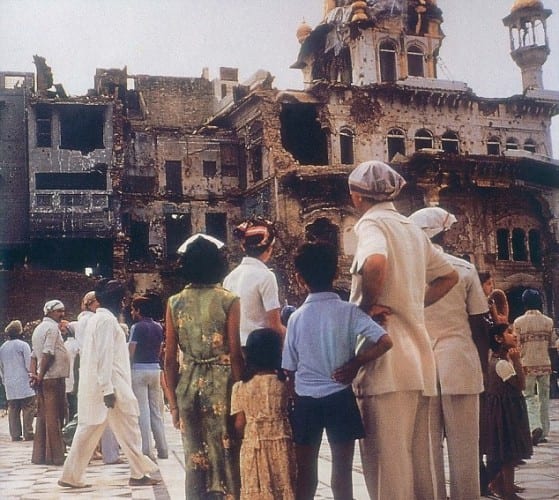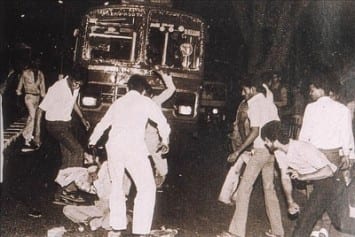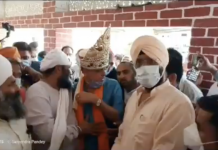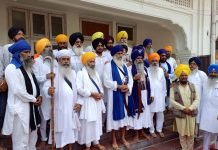


Two significant events in modern Sikh history have recently been commemorated. On the beaches of Normandy in France, war veterans, locals and politicians gathered to commemorate the allied invasion of France, the D Day landings that took place 70 years ago on 6th June 1944 in Nazi-occupied Europe. There were two stages to the Allied assault. Stage one on 6th June 1944, called ‘Operation Neptune’, involved the largest sea born invasion in human history which involved 10,000 boats and ships landing 150,000 troops in one day. Stage two, codenamed ‘Operation Overlord’ represented the allied penetration into Western Europe leading the rapid liberation of France and eventually defeat of Hitler and the 3rd Reich.
Though the Sikh contribution to both the 1st and Second World Wars is widely recognised, what is less known is the Sikh involvement in these two operations. In fact, Bhupinder Singh in his book How Europe Is Indebted To The Sikhs – World War II, the Royal Indian Air Force and Sikh pilots were involved some of who who have memorials in the United Kingdom at Smaads in Runnymede. For example, Pilot Officer Rajender Singh Sandhi and Flying Officer Jagjit Singh, both of the Royal Indian Air Force, participated in the airborne landing. Moreover, the amphibious landing of Allied infantry and armoured divisions included many Sikh Regiments on the coast of France.
Similarly, in another time and place, 30 years ago, on 6th June 1984 we witnessed the enactment of another military operation, and like D-Day, the operation involved some 150,000 troops, but with one significant difference; on this occasion, the fight was not to defeat fascism, but the Indian Army invading a holy place and killing thousands of its own citizens.



Stage one code named ‘Operation Blue Star’, was led by Gen. A.S. Vaydia and executed by General K. S. Brar after a refusal from Lt. Gen. S. K. Sinha, a Hindu military man and the then Vice-Chief of the Indian Army, on the grounds that his job was to defend Indian citizens. It involved a full-scale military assault on the Darbar Sahib (Golden Temple) in Amritsar Sahib, India. The pretext to the attack was that some so-called armed terrorists were holed out in the temple. Over a period of 4 days, large sections of the Darbar Sahib complex, the holiest shrine for the 30 million world wide Sikh community, were destroyed. Though we have never discovered the actual numbers of casualties, ‘official’ Government estimates are around 1000 dead, but the SGPC confirmed that 10,000 pairs of shoes remained unclaimed by pilgrims.
Operation Blue Star was quickly followed by stage two codenamed ‘Operation Wood Rose’, which resulted in Indian Army troops attacking another 50 historical Gurdwaras and many more in villages as they fanned across the Punjab countryside. Their orders were to round up amridhari (baptised) Sikh boys and men of fighting age and take them into custody. The ‘official’ line was that the India was fighting a Pakistani inspired insurection leaving the government no choice but, under a state of emergency, to round up so-called terrorists and separatists who posed a threat to the integrity and sovereignty of India. In a period of days and weeks, tens of thousands were imprisoned, tortured, and in some instances killed—and those accused of providing shelter and food for the so-called ‘terrorists’, many simple villagers, were not spared either.
Tragically the events from June to October 1984 were but a precursor to a full-scale pogrom unleashed on Sikhs across India. On 31 October 1984, Indira Gandhi, the then Prime minister of India, was assassinated by two of her Sikh bodyguards in what is viewed as an act of vengeance or vigilante justice. Subsequently, over a period of 4 days under the gaze of world leaders who had arrived to attend Mrs Gandhis funeral, the Sikh suburbs of Delhi went up in flames and an estimated to 10,000 innocent Sikhs were massacred in Delhi alone.
Though portrayed as a ‘communal riot’ that resulted from a spontaneous outburst of anger by Hindus against Sikh, all the evidence points towards a State led genocide against innocent Sikhs. Specifically, subsequent enquiries and testimonials point towards The Congress Party high command and in particular Indira Gandhi’s son Rajeev who, when asked on national media about the pogroms being unleashed against innocent Sikhs, simply replied, “when a big tree falls the ground does shake.”



But the horror does not end in 1984. Throughout the next 10 years, under the aegis of the Terrorist and Disruptive Activities (Prevention) Act (TADA), which was in force in Punjab between 1985 and 1995, an estimated 100,000 innocent people, both Sikh and Hindu, were victims of state sponsored terrorism in the guise of fake encounters or extra judicial killings by the Punjab Police force.
30 Years later the psychological, and in some cases physical, scars from 1984 still traumatise the Sikh community. In many parts of Punjab, Sikhs, young and old, male and female, have succumbed to shocking levels of alcohol and drug addiction.
On Sunday, 8th June thousands of people, Sikh and non-Sikh, marched through the streets of London demanding ‘Truth, Justice and Freedom.’ Similar events have been held throughout the world, though interestingly, in India and specifically Punjab, protests have been muted. Some people suggest that the events of 1984 need to be consigned to the dustbin of history, that unless they do so Sikhs will never be able to move forward. Others argue that, until justice is done, even suggesting we forget 1984 is an act of betrayal against many thousands of people who sacrificed their lives and the remaining families who continue to suffer.
Whatever one’s position, there can be no doubting that, despite the passage of time, for large sections of the Sikh community both in India and the diaspora, the memory of 1984 is still fresh and the desire for justice and freedom is as strong as ever. That said, mixing in with the crowds, observing the banners and listening to the speeches, one gets a real impression that the desire to move on to some closure was there. Though the slogans for Khalistan were still prevalent, the anger and resentment displayed on previous occasions was largely absent and the true spirit of Sikhi, was clearly evident, both in the way the whole event was organized and in the general unity (ekta) that was being displayed by everybody present.
As Kulwant Singh Dhesi, an influential Sikh intellectual passionately argued in his speech, “now is the time to let go of our enmities and embrace each other despite our differences. Irrespective of the past and any differences we might have in our political views about Khalistan, we must not let these get in the way of working together.”
As well as a call for Sikhs to unite, there was another important feature, namely unity amongst the Sikh media. This was powerfully displayed in the nesting of the logo’s of the three Sikh TV channels on the microphones. Various speakers acknowledged the role of the media and that without the absolute unanimity displayed by all three TV channels and other Sikh media outlets, the event would not have succeeded. Put simply, the Sikh media has transformed and re-energised the Sikh freedom and justice movement and the march on 8th June demonstrated the power and influence it has over Sikh affairs. And so, in taking on its responsibility for continuing to put forward the Sikh case, it is also incumbent on the media to not only maintain this unity that the 8th June commemoration generated, but to lead by example.



Given the general conviviality that has broken out amongst various Sikh organisations and the media, there is an opening to cement unity in developing a protocol for all the Sikh media, be it the TV channels (both terrestrial and web based), Radio stations and the two main print media. One of the most common calls on all media outlets is panthik unity, but there is also a responsibility to lead by example. One practical way forward could be to establish an equivalent of ‘OFCOM’ for the Sikh media possibly facilitated by the Sikh Council UK. As well as developing some general protocols such a body could also provide a space for arbitration therefore avoiding expensive and publicly damaging complaints. Indeed, such a body could become a model for all Sikh institutions and especially gurdwara’s to resolve internal disputes.
There was a time when Sikhs in India had some clout, but sadly today for those in power we are simply one of many sections of Indian society that have grievances and the Sikhs have never been more divided. And put in perspective of the millions of people who still experience abject poverty in India, of the routine nature of police brutality and rampant corruption, of violence against women and so-called untouchable classes and the epidemic of female foeticide, then perhaps one can understand why the Sikh cause may seem to be of less significance.
Given our numbers, Sikhs are destined to minority status in most contexts and therefore our future survival and prosperity is critically dependent on our capacity to unite. There are glorious historical examples of this happening, such as the periods of Bandha Singh Bahadur and Maharaj Ranjit Singh. On both occasions, despite their relatively low numbers, unity and an absolute commitment to humanitarian principles, enabled them to become popular rulers. If this happened in the past, then there should be no reason why it can’t happen in the future. The question is whether the leaders of the Panth, be they jathebandhis, intellectuals, journalists, or activists are capable of rising to the challenge.
When we reflect on the courage and sacrifices of the 200,000 Sikh soldiers who served in the British Army we feel a sense of pride and honour. The attack on the Darbar Sahib in 1984 robbed us of our dignity and we have not really fully recovered from that event and awful decade of state sponsored violence. Yes we were/are victims of genocide but victimhood will not enable us to move forward. We may never get justice but we must reclaim our sovereignty, self- confidence and realization that the Khalsa is and never has been a victim. 30 years after 1984 we need turn a new leaf and begin to narrate a new future, of a progressive, globally successful unified people whose success is inspired by the wonderful teachings of our ultimate leader, Sri Guru Granth Sahib Ji.
And in the end, it is only through the Guru that we will achieve both unity and chardhi kala.





We will not get justice from the Indian govt. however, this is not the first time Sikhs have faced genocide and we are not a community to beg for anything. We need to move forward but not forget, we have been blessed as a global community. We need to participate actively in the communities we live, practice the humanatarian teachings of Sikhi, be united on Sikh political & commercial causes and always support our fellow Sikhs.
It makes me proud to go anywhere in the world from Osaka to Mauritius, Lebanon and be able to meet Sikhs living there. A Sikh should never feel alone they are part of a global community and we need to help them maintain their Sikhi irrespective of where they are living.
An interesting piece that asks of the legacy of the 1984 genocide. Why not make it tangible so that it cannot be easily unremembered?
free khalistan!